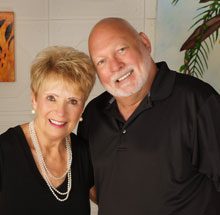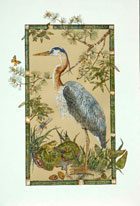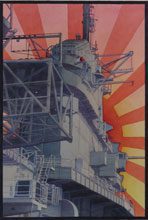 During the second half of the 19th Century and early in the 20th Century, most American architects were trained in Paris, France under the influence of the Beaux Arts system. At that time the predominant form of architectural visualization was painting and drawing by hand. To be able to sell designs of buildings, architects first had to become masters of drawing and watercolor painting. Visions of buildings they created using drawing and painting by hand were not just technical documents. To a large degree they were works of art communicating the architect’s visions and dreams of buildings yet to be born. When you look closely at these drawings you can clearly see that they belong to a different mindset and to sensitivity that is far removed from the modern-day computer-generated building designs.
During the second half of the 19th Century and early in the 20th Century, most American architects were trained in Paris, France under the influence of the Beaux Arts system. At that time the predominant form of architectural visualization was painting and drawing by hand. To be able to sell designs of buildings, architects first had to become masters of drawing and watercolor painting. Visions of buildings they created using drawing and painting by hand were not just technical documents. To a large degree they were works of art communicating the architect’s visions and dreams of buildings yet to be born. When you look closely at these drawings you can clearly see that they belong to a different mindset and to sensitivity that is far removed from the modern-day computer-generated building designs.
With the introduction of modern design principles created and influenced by architects from the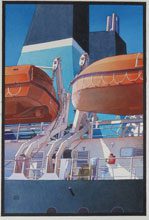 Bauhaus School, much of the emphasis on the “old-school” presentation skills began to fade. Fortunately, Cornell University College of Architecture continued to emphasize the importance of drawing skills, even during the 1950’s and 1960’s, when Bob Steinmetz studied architecture there.
Bauhaus School, much of the emphasis on the “old-school” presentation skills began to fade. Fortunately, Cornell University College of Architecture continued to emphasize the importance of drawing skills, even during the 1950’s and 1960’s, when Bob Steinmetz studied architecture there.
Bob first pursued an education in architecture because of his interest in drawing. Architecture was a perfect fit that enabled him to develop and utilize this skill, and for almost 30 years of practice as an architect, drawing was his constant companion and main tool in his toolbox. Fittingly, he retired from architecture at the turning point in time when computer-aided-drafting (CAD) began to eliminate the need for drawing by hand. However, Bob continued to draw, only now free to explore his own, personal visions.
To compliment his interest in drawing, he decided to venture into the world of watercolor painting. Over the years he has mastered many of the intricacies of this difficult media by observation and by practice, developing his own methodology for watermedia painting. Although he has never participated in a workshop or art course, the challenge of the “trial and error” process continues to be his primary motivator as an artist.
The quality of his work has earned him “Signature Member” status in America’s two most prestigious watercolor societies, the American Watercolor Society (AWS) in New York and the National Watercolor Society (NWS) in California.
The paintings presented at the Charles Street Gallery belong to his Maritime Series. Many paintings of nautical subjects focus on the beautiful lines and silhouettes of carefully designed luxury vessels. However, the subjects of Bob Steinmetz’s Maritime Series are about a totally different category of vessels. His “Marine Machines” exist for commercial or military purposes and are exclusively designed to satisfy functional needs. Very often they are chaotic assemblages of discordant parts based on a need hidden from the uninformed observer. No effort has been made to design visual harmonies, yet interesting rhythms, shapes, and patterns can be found in the apparent randomness presented in these subjects. Bright colors are present – not for decorative purposes – but to identify functional 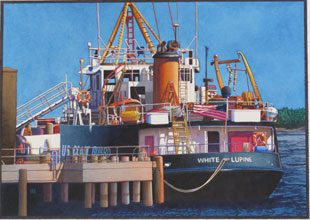 components of the vessel. More than anything else, paintings in this series are dedicated to capturing the raw visual energy of these “Marine Machines”.
components of the vessel. More than anything else, paintings in this series are dedicated to capturing the raw visual energy of these “Marine Machines”.
Although these paintings are based on the artist’s own digital photo images, they are not intended to be “photo-realistic.” In many cases, due to the complexity of the image and to the lack of definition in the original photo, various forms and shapes had to be modified or re-invented to appear more appropriate to the setting and to be visually more resolved. The subjects are based on photographs, but they are pushed towards abstraction by cropping out much of what is seen, by using a zoom lens, and by focusing on the most interesting shapes and relationships. Also, in terms of overall coloration, frequently the original photo served only as inspiration for developing a unique palette for each painting.
Bob’s paintings contain a great deal of detail that is critical to their appreciation. They have been composed and constructed using a carefully controlled process. First, a subject was found and a composition selected which was then carefully recorded with a digital camera. Following this, the second step involved transferring the image to 300 lb. watercolor paper by outlining every aspect of the picture in pencil and at the same time deleting and cropping out any portion that was not contributing to the desired image. In order to refine the overall composition and study the power of its component parts, a monochromatic underpainting was developed with water-thinned acrylic paints. This somewhat unusual step establishes the overall image with light, medium and dark values of a single color and/or with more neutral gray tones. Areas to be the lightest value were not painted, preserving the pure white of the paper. In the fourth and final step, transparent watercolor paint was applied over the underpainting. This step included layering, graded washes, and occasionally dry brushing. In this final step the full color concept for the painting was developed and finalized, including the use of areas of saturated, primary colors as accents.
The subject matter of Bob’s paintings varies from landscapes and maritime objects, to buildings and even figure studies, but certain characteristics are present in all of h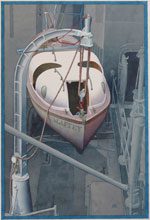 is work. The most obvious is balanced and strong composition, precise and refined delineation of the painting subject, and high attention to detail. His paintings are always developed to have a compelling image from a distance but also to be visually interesting and refined on close inspection.
is work. The most obvious is balanced and strong composition, precise and refined delineation of the painting subject, and high attention to detail. His paintings are always developed to have a compelling image from a distance but also to be visually interesting and refined on close inspection.
Bob’s work requires a high degree of skill. Technical precision is at the center of his approach, but the result of his work is more than just a show of exceptional technique. Bob looks very carefully at the world with his discerning eye and when he finds shapes and forms of interest he employs his exquisite technical skills to crank it up and when fortunate, touch the realms of art.
Bob Steinmetz’ exhibit will open at the Charles Street Gallery on Friday, March 30th, with a reception at 5:30 pm, and will run through April 28th. The Charles Street Gallery is located at 914 Charles Street, Beaufort. www.thecharlesstreetgallery.com

